About influence on company since the Great East Japan Earthquake disaster,
Mr. Fukuo Sakurai, Chief Executive Officer of Techno Tohoku Corporation
says that the principal earthquake on March 11 was certainly serious, but
the damage of the aftershock of April 7 was rather bigger.
The Tohoku ? Pacific Ocean Earthquake (magnitude 9.0) that occurred at
about 2:46 on the afternoon of March 11 with Sanriku offing as its seismic
center brought quake registering a weak-6 around Izumi-ku, Sendai city
where the headquarters office of Techno Tohoku is located. Though there
were intermittent after quakes afterwards, wariness to after quakes was
gradually moderating towards the beginning of the next month.
However, having a seismic center off the coast of Miyagi prefecture, an
M. 7.1 aftershock occurred at about 11:32 pm on April 7, nearly a month
after the main shock. Earthquake intensity of a strong 5 was observed around
Izumi-ku.
As a result, Whereas PC monitors and some lockers fell down during the
main shock, almost all lockers, bookshelves, and partitions fell down during
the aftershock not to mention monitors, with materials being scattered
on the floor.
The second user company we introduce this time is Techno Tohoku Corporation,
a civil engineering consultant that covers various fields. Techno Tohoku
has been using FORUM8 products mainly as civil engineering software till
now. In addition, Techno Tohoku played an important role in developing
"Bridge inspection support system" of which FORUM8 released the
first edition in January 2008, by technological cooperation. Therefore,
we focus on Bridge Maintenance Group, First Engineering Department and
Bridge Substructure Group, Second Engineering Department.
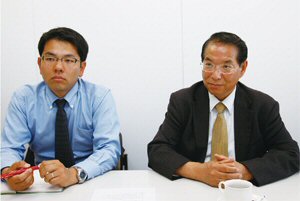 |
|
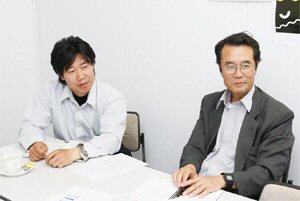 |
 (from left) Mr. Kiyohiko Sato (Bridge Substructure Group, Second Engineering
Department); (from left) Mr. Kiyohiko Sato (Bridge Substructure Group, Second Engineering
Department);
Mr. Fukuo Sakurai, Chief Executive Officer;
Mr. Naoki Matsunaga, Mr. Kyuichi Fujita (Bridge Maintenance Group, First
Engineering Department) |
| Covering Highways, Transportation, and Various Types of Structures Including
Bridges |
"We don't have so many projects that are dealt only by our company.
Rather, we have more subcontract works (to support the contractor)".
Techno Tohoku is founded in 1989. Starting mainly with design of structures
including highways and bridges, it has gradually expanded the fields and
services.
Currently, it is based in the headquarters office (Izumichuo, Izumi-ku,
Sendai city) and Koriyama office (Omachi, Koriyama city, Fukushima), having
about 50 employees. Its services are as follows.
(1) Highway / a transport technology such as preliminary / detailed design
of highways, transportation planning, traffic simulation, and data analysis
(2) Structural technology such as design of bridge superstructure / substructure,
bridge inspection, design of the electric wire underground multi-purpose
duct, and sewerage design
(3) Environmental technology for investigating natural environment and
living environment
(4) Hydraulic engineering for designing river and coastal structures
(5) Disaster prevention technology for planning and designing countermeasures
for rock fall and slope failure.
Mr. Fukuo Sakurai says Techno Tohoku has a wide range of services for a
subcontractor.
Bridge Maintenance Group, First Engineering Department conducts field survey,
tests, and repairing design for various structures including bridges.
Public works expenditures are reduced while a large quantity of the social
capital stock provided during the high economic growth period reach update
time. Along with this, in recent years, asset management has attracted
attention. This means performing maintenance with the highest cost-effectiveness
by regarding social capital as asset widely and grasping its damage or
deterioration over its life cycle. In addition, toward extension of life
of the social capital, the significance of knowledge about various maintenance
and repair / reinforcement technology is also getting greater. In this
context, the business records of bridge inspection for Ministry of Land,
Infrastructure and Transport and local government that Techno Tohoku undertakes
amounts to around 300 bridges a year.
Bridge Substructure Group, Second Engineering Department is in charge of
design work of bridge substructure that is the mainstream of Techno Tohoku
since its foundation and other general structures, boasting abundant experiences.
Not to mention six prefectures of Tohoku, it responds to projects in Kanto,
Kansai, and Hokkaido. Other than design of new structures, it puts emphasis
on seismic reinforcement design as well as dynamic analysis.
One of the unique attempts of Techno Tohoku is Civil Design Group established
in the Second Engineering Department. Staff members of a short-term contract,
who had been assigned to each department, were reorganized as an independent
function. By gathering auxiliary works such as drawing or quantity calculation
that extends to multiple sections into the group to have them performed
in sharing them, efficiency of the organization as well as leveling the
works are designated.
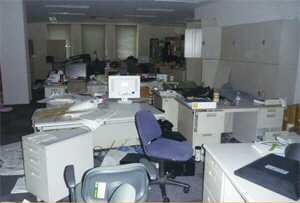 |
|
 |
 Inside the office right after the earthquake disaster (left), Inside the office right after the earthquake disaster (left),
and inside the office on business activities shot from the same direction
(right) |
| Commutation and Lifeline Temporarily Hindered |
In this earthquake disaster, not only the earthquake itself but also massive
tsunamis generated by this brought about damage compositely, which is assumed
the greatest in the history of disasters in the end. In Miyagi in particular,
the casualty figure exceeds 60% of the whole disaster area, indicating
how serious the damage is.
In Techno Tohoku Corporation, though there was no human damage to the employees
and their families, some had their parents' houses washed away by the tsunami.
In addition, destruction of buildings or depressions of highways were frequently
seen around the headquarters office. Moreover, an overpass was damaged
between Izumichuo Station, that is the nearest station to Techno Tohoku
on Sendai-city subway Namboku Line and the adjacent Yaotome station. Its
restoration took until April 29 when operation was reopened on the whole
line.
In the headquarters office, as mentioned above, all PC monitors dropped
from the desk in the main shock on March 11. For some time after that,
office staff laid the monitors on the desktop when leaving the company
to prevent dropping. In April, when they returned to the usual pattern,
aftershock occurred on April 7. All monitor dropped again.
In addition, as to bookshelves etc., a tip-over safety measure had been
taken by fixing them with anchor bolts to the board; consequently, it was
only that some lockers fell down during the main shock. In contrast, anchor
bolt fell out of the board during the aftershock, resulting into greater
damage than the main shock.
But the seismic countermeasure for the server was strengthened when headquarters
office was transferred to the current place from a different building in
Izumi-ku in January 2010. That made it possible not to cause a significant
hang-up in business though plural monitor were broken, says Mr. Fukuo Sakurai.
He continues, "The server might have been broken if it was as used
to be, causing more serious trouble".
Furthermore, since the Company had prepared for the final effort for the
delivery of goods in the end of the fiscal year, it had not a small influence
that the commuting means were interrupted and commodity supply of such
as electricity, water and paper was cut off though temporarily.
Flow Towards Joint Development of "Bridge Inspection Support System"
Evaluation of Software and New Possibility |
The number of routine inspection of bridges undertaken by Techno Tohoku
within the district of Tohoku Regional Development Bureau, Ministry of
Land, Infrastructure and Transport (MLIT) is increasing year by year. After
2006 in particular, it reaches around 300 bridges a year. On the other
hand, those works include not only enormous and simple iterative processes
but also organizing photos and creating a large number of drawings. In
fact, in the end of the fiscal year when these works concentrate, they
got through the works by working overnight or recruitment of extra staff
of short-term employment.
Mr. Kiyohiko Sato, Deputy Manager of Bridge Substructure Group, Second
Engineering Department recalls that they sought for the way of simplifying
these works to improve efficiency. For example, it was required to develop
software to support not to produce an input error when entering information
such as extent of damages or parts based on the created drawing into the
server of MLIT.
It was when MLIT provided "Bridge routine inspection procedures"
(scheme) (March, 2004) that Techno Tohoku proposed joint development of
a program that reflects the scheme to FORUM8. They started working on actual
development around 2006. It took about a year to complete the program,
to which small adjustments were made during another year. It was made into
a product (first edition release) as "UC-1 Bridge inspection support
system" in January 2008.
This records the damage situation based on the close visual inspection
in bridge routine inspection, prepares inspection records, and create member
and damage drawings in conformity with the bridge routine inspection procedure
(scheme). Based on this, FORUM8 also released the 1st version of "UC-1
bridge inspection support system" (National Institute for Land and
Infrastructure Management version) that conforms to "Basic data collection
procedure (scheme) about the highway bridge" (MLIT / National Institute
for Land and Infrastructure Management) in April 2010.
According to the test calculation in the company, the cost required for
the development can be recovered in approximately two years owing to the
effect of introducing the software. Mr. Kyuichi Fujita, Councilor of Bridge
Maintenance Group, First Engineering Department states his opinion that
it leads to advantages beyond expectation. For example, although an expert
finally perform a check, errors decrease, and the staff member of the above-mentioned
Civil Design Group can handle most of the works within a short time.
Mr. Naoki Matsunaga, Manager of the Group considers that the software has
received a certain evaluation up to the level of maintenance design. He
also mentioned future possibilities including application to inspection
of not only bridges but also highways and their incidental facilities and
other structures, or functional expansion such as visualization of damages
and calculation of repair costs.
In addition, Mr. Kiyohiko Sato expects that a tablet PC can be used on
site if the software comes to support cloud-type service, and that it will
lead to easy and speedy work.
Further, in consideration of concern about shortage of skilled engineers
accompanied by rapid aging and birthrate declining in Japan, Mr. Fukuo
Sakurai explains a function of presenting a repairing method of cause-measure
type and improvement of the inspection technology through this, and possibility
of proposing a construction method that links with the cost of repairing
presented.
 |
|
 |
|
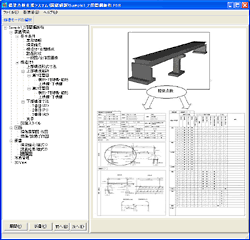 |
 Bridge inspection support system (left) released by FORUM8 through the
technical cooperation of the Techno Tohoku. Bridge inspection support system (left) released by FORUM8 through the
technical cooperation of the Techno Tohoku.
(Right) National Institute for Land and Infrastructure Management version
on the basis of this |
Urgent Inspection in the Disaster Area
Reveals Actual Feeling and Knowledge |
Following Great East Japan Earthquake, MLIT, the Metropolitan district,
and at least the prefectures in the disaster area conducted an urgent inspection
of risk areas of earth-flow disaster. Techno Tohoku also investigated various
fields such as bridges, highways, harbors, rivers, sewerage etc. in three
prefectures of Fukushima, Miyagi, and Iwate.
In conjunction with this, Mr. Kyuichi Fujita, who has been coping with
research mainly on the bridge, realized again that the know-how of the
bridge inspection technology accumulated so far is very useful. He again
persuades necessity of organizing a system in which knowledge obtained
through research can be reflected in the repair design.
Similarly, Mr. Naoki Matsunaga mentioned the difference between the state
of disaster seen through news and the actual feeling acquired on the spot,
based on his own experience of conducting field investigation. He then
draws an approach to aim at towards restoration. That is, to act on the
standpoint of improving the situation around oneself as an individual,
while thinking on a large standpoint of such as town planning and urban
planning as a civil engineering consultant.
"What I felt at the site of disaster (for research after disaster)
is that some cases are seen where the way of collapsing is different from
what had been expected traditionally in this disaster."
For example, the way of breaking that could not be explained in the conventional
method of thinking was seen in the bridge substructure, as Mr. Fukuo Sakurai
says, remarking that it may have some influence on design methods in the
future.
(Interviewed and written by Takashi Ikeno)
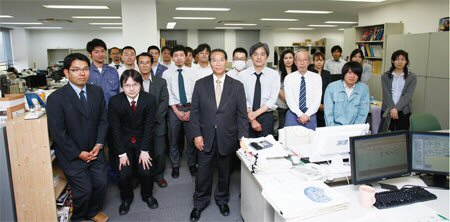 |
 Staff of Techno Tohoku Corporation Staff of Techno Tohoku Corporation
(Mr. Fukuo Sakurai, CEO, at the center in the front row) |
|


